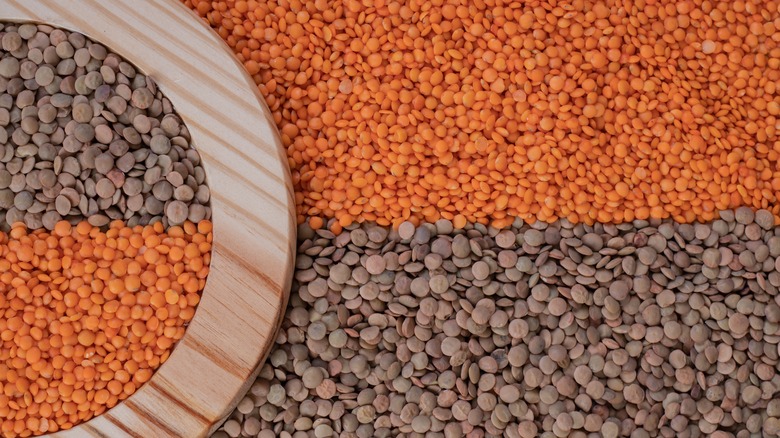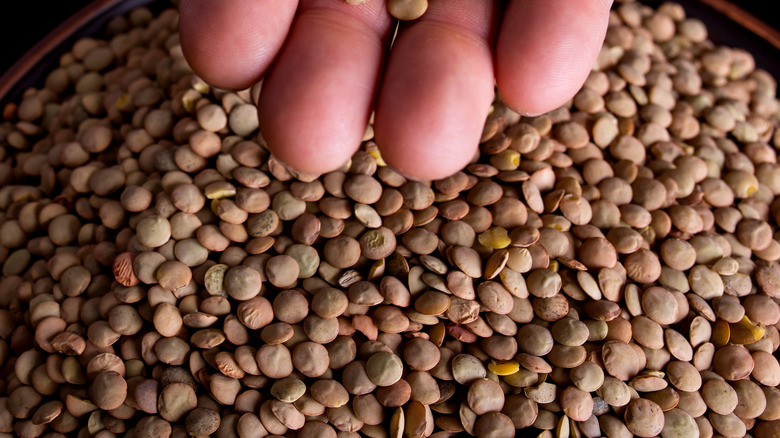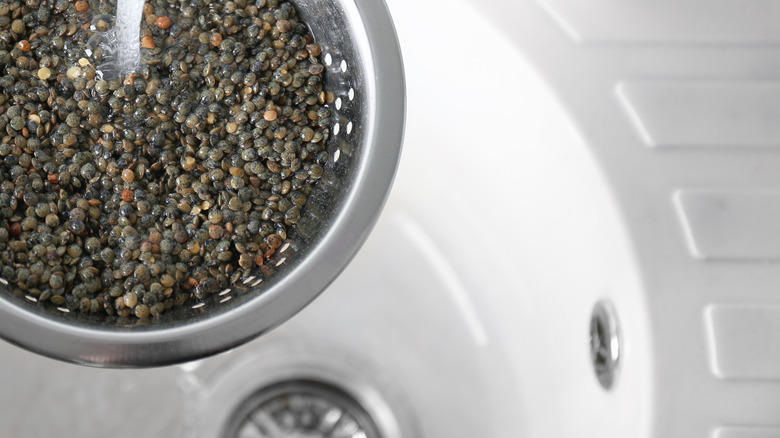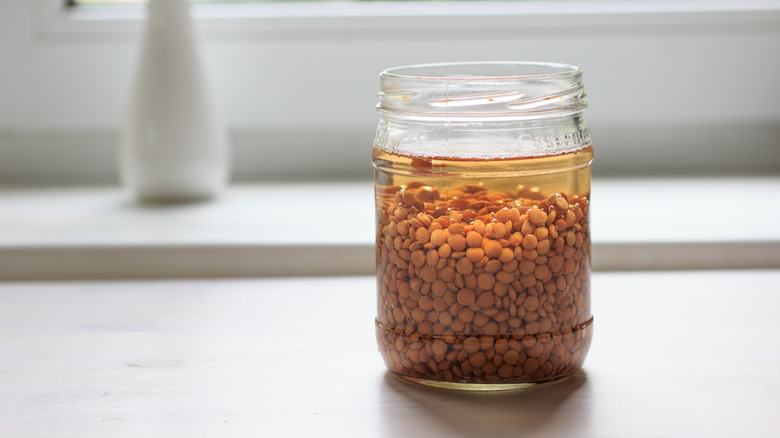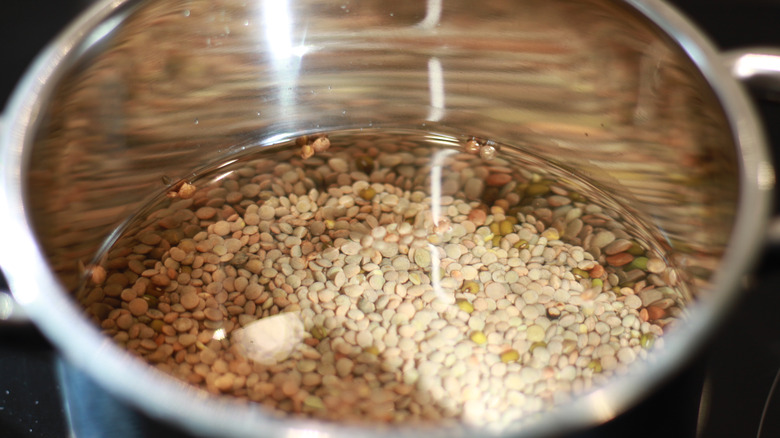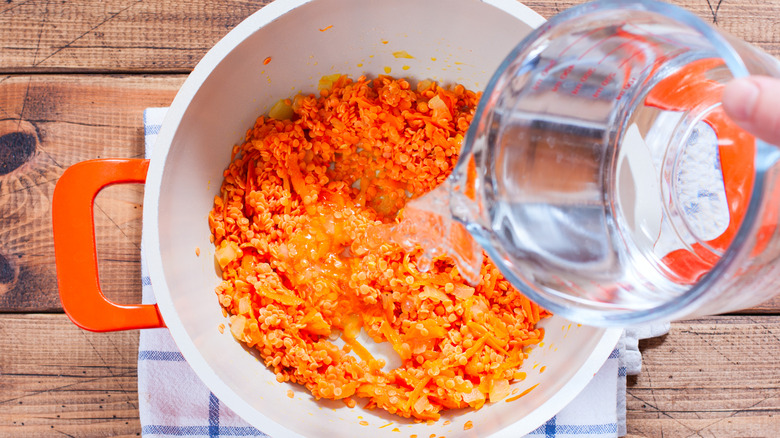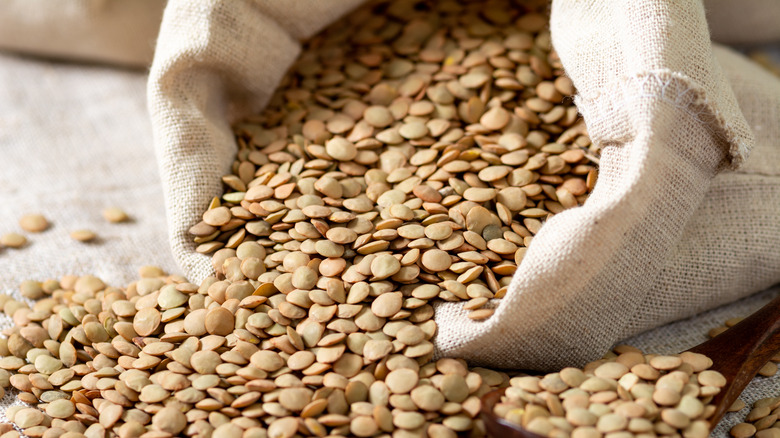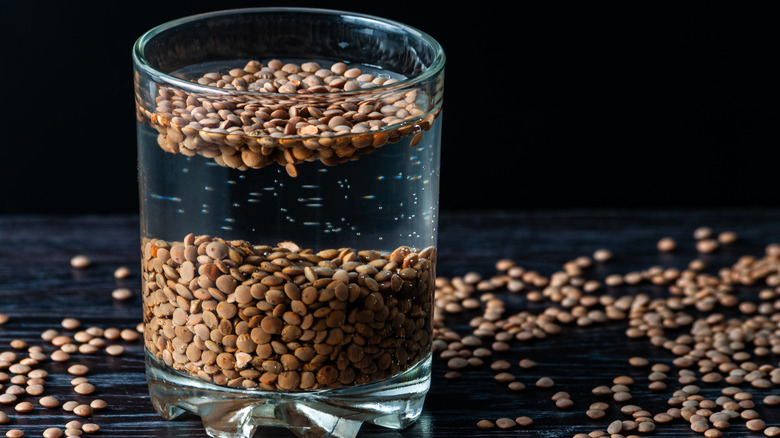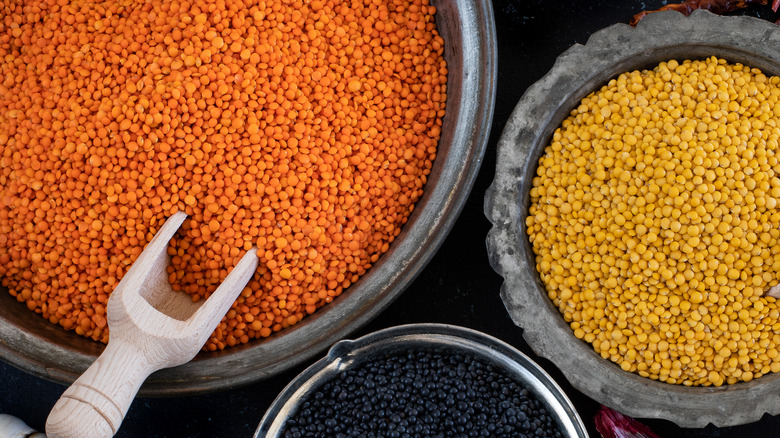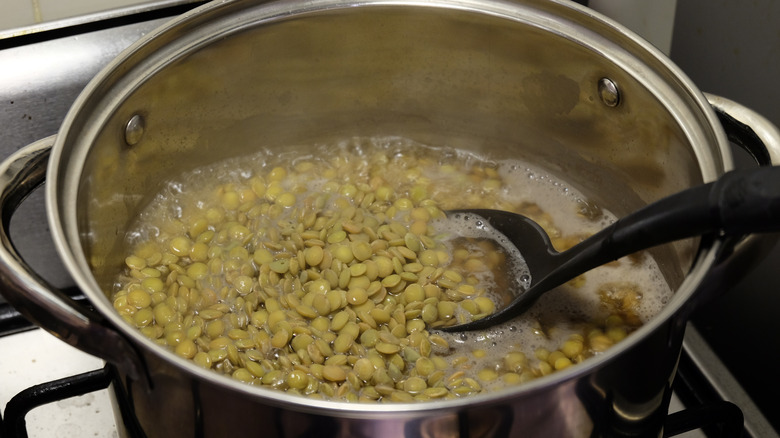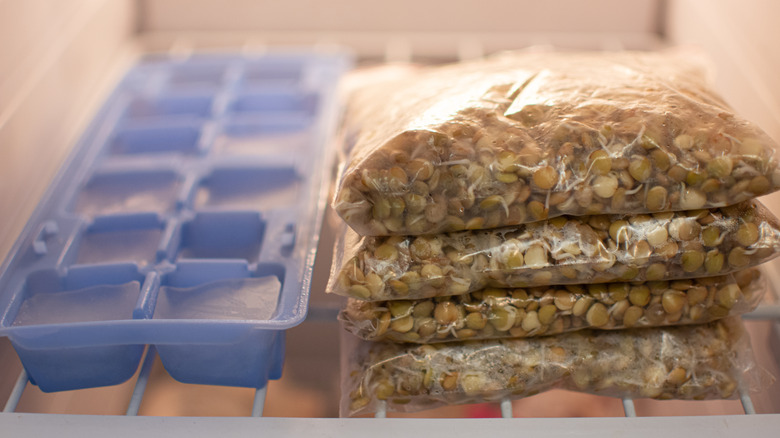Tips You Need When Cooking With Lentils
Lentils can be one of the biggest components to putting together a delicious and nutritious meal on most days. You could turn them into creamy dals and stews plopped over rice, sprinkle them onto salads, blend them into a nourishing soup, or even use them in bowls and bakes as all sorts of fillings.
Even a small bag of relatively inexpensive dried lentils can go a very long way. Although the exact nutritional content of lentils varies depending on their type, a cup of cooked lentils roughly contains about 17.9 grams of protein and makes up for 37% of your daily recommended iron intake (via Healthline). Both are crucial nutrients to consume especially if you follow a meatless vegetarian or vegan diet.
Suffice to say, there are several reasons why you should be eating more lentils — they're nutritious, cheap, and fairly easy to cook. But if there's one thing to know about these tiny edible seeds, it's that using little tricks can make all the difference in the world. With a few simple tips to elevate your lentil-making skills, you'll be able to make the most of all that these little legumes have to offer.
Sift through your lentils
If you've been tossing lentils straight out of the bag into a pan, you're probably not the only one. One of the biggest mistakes you've been making with lentils is not sorting through them first. Not only is it entirely likely for small pebbles and other debris to sneak into your lentils, but once you lay your pebbles onto a flat surface, you'll be surprised to see just how differently shaped, sized, and colored the seeds can be.
Beyond just looking visually unappealing, the lentils' size and color also indicate their ripeness stage. Larger lentils tend to be more unripe than smaller ones and take longer to cook. Sifting through your lentils to ensure that they're as uniform as possible ensures that they cook evenly so that you're not left with hard bites of lentils in your dish.
According to The Noil Kitchen, one of the best ways to sift lentils is by spreading them onto a flat white plate. First, you're looking for anything that's pretty much not a lentil. The next step is to pick out any chipped pieces or seeds that look larger in size and those that have a different colored hue.
Rinse them properly
While pebbles, stones, and other debris may be easily plucked out through a quick sift, a lot of dust and dirt could also be sneaking into your plate when you prepare lentils. According to FoodHow, lentils are delivered straight from farms after they are dried and sold in bulk bins or packages. This means that there's a good chance that your dried lentils have a thin layer of dust on them, even if it isn't quite discernible to the eye.
Luckily, this is nothing a good rinse in water can't solve. Per Chez Moi, a good way to rinse your lentils is by placing them in a bowl and covering them in cold water. Then, grab handfuls of lentils and rub them between your hands to eliminate the dust and dirt. The water turn milky, especially with split red lentils that tend to be dustier than their counterparts. You should repeat this process until the water runs clear, which can take as many as seven washes for mung red lentils, but as few as two washes for green and brown lentils.
Don't rush through soaking the lentils
To soak or not to soak is one of the biggest conundrums when it comes to cooking lentils. While larger legumes like kidney beans and chickpeas take longer to cook and are often soaked, lentils tend to cook much quicker in comparison. Soaking them can seem more effort than it's worth.
Healthline notes that lentils contain certain anti-nutrients like lectins and phytates that hinder your body's ability to absorb other nutrients that the seeds contain. This is why eating lentils can sometimes cause digestive issues like bloating and gas. Soaking, however, can make these anti-nutrients inactive. However, according to PureWow, there's yet to be definitive research that links lentil-induced upset stomachs with anti-nutrients and that it's more likely to be a cause of the high fiber content in them.
Regardless of whether the anti-nutrients present in lentils cause tummy issues or not, there's certainly no harm in adding an extra step. A minimum of two and maximum of 12 hours is a good time to let your lentils soak in water. As an added bonus, soaking lentils first can make them more tender once cooked.
Use enough water to cook them
One of the golden rules of cooking lentils is that they expand when cooked, much like rice. In fact, according to A Couple Cooks, lentils increase in volume by more than twice their size upon being prepared. This means that you not only want a pot that has enough room for the lentils to swell up, but you also need to give the lentils enough water to do their thing.
When it comes to brown and green lentils, in particular, a 1:3 ratio of lentils to water is a good rule to follow. That is, for every cup of lentils, you should be using three cups of water. The water doesn't need to be boiled first — you can let the lentils and the water gently heat up to a simmer together.
Veg Kitchen notes that lentils cook similarly to pasta in water because they don't absorb all the cooking water. The site adds that if time permits, you should allow your lentils to sit in the covered pan of water for 10 minutes or so once you turn off the heat.
Save the lentil water
You may already be aware that there are number of uses for leftover pasta water. While you could throw the excess water leftover from boiling lentils down the drain, Reddit suggests that you could actually be sitting on liquid gold. If the dry texture of cooked lentils is what puts you off from cooking the protein-packed seeds, Redditors suggest saving your cooking water. Take a small portion of cooked lentils, blend it with the help of some lentil water and butter, and mix the sauce into the rest of the lentils to make your final lentil dish creamier.
The lentil water can also be repurposed beyond the final legume-based dish. Not only can you cook rice in the leftover lentil water but it can also be used as a sort of broth or stock for soups and stews as it brings a wonderful earthy flavor to the final dish.
Add flavor to lentils while cooking them
You don't have to wait until your lentils are cooked before you get to the box of spices to start flavoring them — the process of flavoring lentils begins right when you boil them. Adding aromatics to the pot for recipes like red lentil soup with lemon is one of those things that separates a good bowl of lentils from a great bowl of lentils.
You can infuse all sorts of spices and seasonings into the water that you will be boiling your lentils in and simply pluck them out later — think bay leaf, a handful of garlic cloves, or even a chunk of onion. Alternatively, you can first sauté some aromatics in the pot before you get on to adding water and boiling lentils in it.
Another way to pack heaps of flavor into your lentils, is to start thinking beyond just water — aromatics or not — when it comes to boiling lentils. Meat or vegetable broths, for example, can be swapped with water in equal proportions and will make your lentils taste even better than they already do. Cooking lentils in broths or stocks is an especially excellent idea if you're sprinkling them onto salads where these little seeds can bring all the flavors of the liquid.
Use fresh lentils
Lentils seem like they have a lifespan that goes on for eternity, and there's a good reason for it. According to Does It Go Bad, dried lentils come with a best-by date rather than an expiration date. This means that although lentils maintain their quality and nutritional value for at least two to three years when stored away from hot or damp environments, they are edible for much longer beyond that and well past their best-by date.
While this may make it seem like lentils can be hoarded in advance and used for years on end, the site points out that the nutrients packed inside the seeds lessen over time. Not only does using an old batch of lentils mean that you're missing out on all the goodness that the legumes potentially offer, but older lentils also take longer to cook. As they age, lentils become drier, making them more challenging to cook than fresh ones. So if you're mixing the leftovers from an old bag of lentils with a fresh one you just got from the store, don't be surprised if you find some morsels that are perfectly soft but others that are harder and feel uncooked — fresh lentils will cook much quicker than old ones.
Consider brining your lentils
Did you know that there are a lot of things that you could be brining beyond Thanksgiving turkey or a jar of cucumbers? According to culinary scientist Jessica Gavin, even lentils can be brined. In fact, there may be several advantages to doing so. Giving your lentils an hour-long soak in warm water and salt solution helps break down the pectin in the outer shell of the seeds and exposes them to more water when cooked. This means that brined lentils are more malleable, their skins are less-susceptible to bursting, and they tend to hold their shape much better when cooked.
Because brining works by softening the skins of the legumes, it's best to only brine lentils that actually still have an outer shell — think green, French green, brown, and Beluga lentils or Lentilles du Puy. Brining would not be effective with varieties like red or yellow lentils that have already been hulled and are meant to be used in dishes that require them to disintegrate and become mushy.
Use the right kind of lentils and cook them appropriately
Several different types of lentils are categorized by their colors — green, red and yellow, brown, and black. One of the biggest pitfalls of cooking with lentils is assuming that all types of lentils taste the same, can be used interchangeably, and be prepared the same way.
Each variety of lentil is more suitable for a different kind of dish and is supposed to be prepared accordingly. Red and yellow lentils, for example, have a sweeter flavor and are more pliable to becoming mushy and losing their texture than other varieties. As a result, these lentils tend to cook much quicker than their counterparts and are best left to dishes that require the lentils to be pureed into a creamy mixture.
Black lentils are quick to cook, but their earthy flavor lends them well to being paired with protein or veggies like mushrooms that are meaty. Brown and green types of lentils on the other hand, hold their shape well even when they are cooked. Green lentils, Chateline has noted, can take up to 45 minutes to soften up and taste quite peppery which can be a nice layer of flavor to add to salads or be used as a side dish. Depending on what it is that you're making, it's important to choose the right type of lentil and account for the time it takes for it to cook.
Add oil to stop your lentils from foaming
As nutritious, cheap, and easy to cook as lentils are, there are a few things about them that can be less than appetizing. First, it's very easy to undercook these seeds; when not prepared properly, they may end up with an unsavory texture and can even cause digestive issues (via Healthline). Then there's that mucky water from rinsing the lentils that can make even someone with a cast-iron stomach wonder how much dust they're consuming alongside the protein. Finally, if that doesn't do it for you, there's the slimy odd-colored foam bubbling away on your lentils when you're boiling them.
According to Beans And Whatnot, lentils contain a natural chemical called saponin which reacts with water to create a foamy lather on the surface. Although it is entirely safe to consume, there's no denying that the grey foam is unappealing to the eye. But fret not. You don't have to stand by the pot of simmering lentils and painstakingly skim off the foam layer each time it forms. Instead, there's a far easier solution: a dash of oil. Drizzle in a little bit of oil into the water that you're going to be boiling the lentils in, and it will form a barrier around the seeds, effectively reducing the foam that forms on top.
Prepare them in advance
There's no denying that some lentils cook quicker than others, but on busy weekday nights, even that can seem like a little too much time to spare on dinner. Luckily, lentils are one plant-based protein that fares well in the freezer and can be prepared well ahead of time. Freeze That Food reports that lentils can be frozen both by themselves and when part of another dish, like a curry.
Foods Guy suggests that it's best to freeze lentils that have been cooked first and then be allowed to dry for a little bit. Getting rid of all the moisture from cooked lentils will ensure that they don't stick together into little clumps in the freezer if you intend to use the frozen lentils in dishes where they must be cooked. Further, it's best to cook the lentils a little less before freezing them and consider leaving them al dente.
Dried lentils that have been cooked will stay good in the freezer for about six months. You can even freeze canned lentils for up to two months. Then, simply thaw them in the fridge, microwave, or in some warm water when you're ready to eat them, and you'll have a nutritious meal on the table in a jiffy.
